 CONTENTS
CONTENTS  HOW TO USE THIS EBOOK Select one of the chapters from and you will be taken to a list of all the recipes covered in that chapter. Alternatively, jump to the to browse recipes by ingredient. Look out for linked text (which is in blue) throughout the ebook that you can select to help you navigate between related recipes. You can double tap images and tables to increase their size. To return to the original view, just tap the cross in the top left-hand corner of the screen. INTRODUCTION From light lunches to something more substantial soups can be healthy, comforting, hearty and nourishing, as well as easy to incorporate into your daily diet.
HOW TO USE THIS EBOOK Select one of the chapters from and you will be taken to a list of all the recipes covered in that chapter. Alternatively, jump to the to browse recipes by ingredient. Look out for linked text (which is in blue) throughout the ebook that you can select to help you navigate between related recipes. You can double tap images and tables to increase their size. To return to the original view, just tap the cross in the top left-hand corner of the screen. INTRODUCTION From light lunches to something more substantial soups can be healthy, comforting, hearty and nourishing, as well as easy to incorporate into your daily diet.
Homemade soup tastes delicious, is inexpensive to prepare and can make a sustaining, healthy meal for the whole family. Cooking from scratch ensures you know exactly what you are eating, without any of the preservatives or ingredients often listed on packets or tins of processed foods. Now preparing soup at home is easier than ever before. Using a soup maker allows you to cook with fresh ingredients, reduce waste and save time in the kitchen. Not only are soup makers affordable but using leftovers to create a tasty soup is an efficient way of saving money and avoiding waste. Its also easy to cook large quantities and freeze portions when you have an abundance of ingredients (when the allotment is over-producing or to use up leftovers in the refrigerator, for example).
Most soups are easy to freeze in single portions, so when you need a quick meal its simply a case of microwaving a portion from the freezer. A soup maker is the equivalent of one-pot cooking add whatever roughly diced ingredients you have to spare, whether fresh, leftover from your refrigerator or garden surplus, add herbs, spices and stock and in as little as 2030 minutes you have delicious homemade soup. After a quick rinse the soup maker is ready to go again. WHAT TO LOOK FOR IN A SOUP MAKER There are lots of affordable soup makers available on the market and each one will be accompanied by a manual, do take time to examine your particular model and familiarize yourself with the settings, as these tend to vary slightly between brands. If you are planning to buy one then there are a number of things to consider, as some have more advanced features than others: Saut function heats the cooking jug so you can saut some of the base ingredients, such as bacon, onions, celery, peppers and spices, before the rest of the ingredients are added. Sauting ingredients in the same jug as the soup is cooked improves the taste, as all of the flavour is retained during the cooking process.
Smooth setting perfect for soup recipes that require a smooth consistency, such as . The program ensures the ingredients are blended to a smooth, lump-free consistency and gently cooked at the right temperature. Chunky setting good for more rustic soups such as , requiring a chunkier consistency. The program allows the ingredients to be heated for longer to ensure the chunky ingredients are fully cooked. Blender function this allows blending after the soup is made, and further ingredients can also be added to the cooked soup before it is blended. This setting does not heat the soup.
Juicer some soup makers can also be used as a juicer for making smoothies or milkshakes from fresh ingredients. This setting does not heat the ingredients.  USING YOUR SOUP MAKER There are some factors to take into consideration when using your soup maker: The capacity of the soup maker: This will vary depending on the brand of soup maker you have, so do check the minimum and maximum levels and ensure you stick to them when adding ingredients. If you need to add a little less liquid you may have a thicker consistency soup that can be loosened with extra stock, cream or other liquid when the soup is cooked and served. Saut function in soup makers: In most cases this can only be used with the lid removed from the jug and for no longer than 10 minutes. Sauting is perfect for onions, celery, peppers, carrots or bacon lardons where they need to be softened or browned.
USING YOUR SOUP MAKER There are some factors to take into consideration when using your soup maker: The capacity of the soup maker: This will vary depending on the brand of soup maker you have, so do check the minimum and maximum levels and ensure you stick to them when adding ingredients. If you need to add a little less liquid you may have a thicker consistency soup that can be loosened with extra stock, cream or other liquid when the soup is cooked and served. Saut function in soup makers: In most cases this can only be used with the lid removed from the jug and for no longer than 10 minutes. Sauting is perfect for onions, celery, peppers, carrots or bacon lardons where they need to be softened or browned.
To achieve the best results, cut vegetables into small cubes before frying them in the soup maker, especially if making a smooth soup. Aside from bacon and small amounts of mince (up to 100 g/3 oz), meat cannot be cooked using the saut function or in the soup maker without being pre-cooked first, either by roasting, grilling or frying. If your soup maker does not have a saut function it is best to prepare ingredients in a heavy-based pan before transferring to your soup maker. Achieving the desired consistency: For chunky soup there is no blending required and it is advised that the vegetables are cut into small bite-sized pieces at the start of the Chunky program. If the soup is a little too chunky after cooking, your soup maker may have a that you can use to achieve the desired consistency. Can ingredients be added during cooking? This will depend on the soup maker you are using, but some models allow the lid to be removed during the cooking program (but not while the machine is blending) so ingredients that need less cooking time can be added.
Using a timer when your soup maker is cooking is very useful to understand what stage it is at, so you can add ingredients before it starts to blend, for example. Beware attempting to remove the lid during blending it will cause a lot of mess! How long will the soup take to cook? Typically most programs take between 2030 minutes, depending on your machine and the program you are using. This is exclusive of time spent sauting using models which permit this feature.  The recipes in this book were tested with a soup maker with a minimum capacity of 1.3 litres (2 pints) and a maximum of 1.6 litres (2 pints). The soup maker also featured a saut function which allowed the cooking process to be paused and the lid removed so that further ingredients can be added. It is worth noting that you should not saut in a soup maker for longer than 10 minutes for risk of the ingredients getting burnt.
The recipes in this book were tested with a soup maker with a minimum capacity of 1.3 litres (2 pints) and a maximum of 1.6 litres (2 pints). The soup maker also featured a saut function which allowed the cooking process to be paused and the lid removed so that further ingredients can be added. It is worth noting that you should not saut in a soup maker for longer than 10 minutes for risk of the ingredients getting burnt.
If your soup maker does not have a saut function, this step can be done in a saucepan, transferring the ingredients to the soup maker after sauting and before cooking on the Smooth or Chunky setting. For many soup makers the average cooking time for Smooth is 20 minutes whereas for Chunky the cycle takes 30 minutes. You may need to adjust the amount of liquid specified for the recipes in this book depending on the minimum and maximum levels set on your soup maker. This may change the consistency of the soup; if it is too thick at the end of the cooking program, stirring in a little boiling water or warmed milk may help to loosen it. SKINNY COURGETTE AND DILL SERVES 4 2 tablespoons sunflower or light olive oil 1 large onion, diced 2 garlic cloves, crushed 500 g (1 lb) courgettes, thinly sliced 800 ml (1 pints) vegetable or chicken stock 12 tablespoons finely chopped dill, plus extra fronds to garnish salt and pepper 50 ml (2 fl oz) single cream, to serve Heat the oil in the soup maker using the saut function. Add the onion and garlic and saut for 5 minutes until softened, but not browned, stirring frequently with a wooden spatula.Add the courgettes, stock and dill, then cook on the Smooth setting.Season the soup to taste, then pour into warm bowls.
Next page
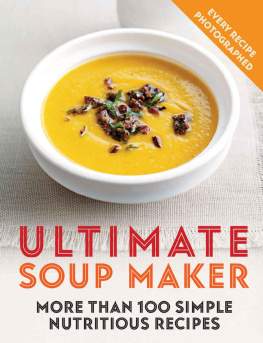
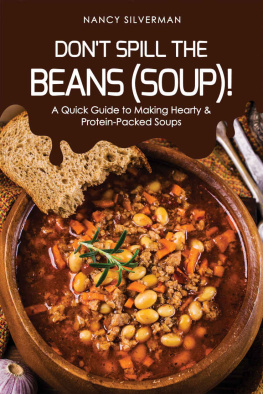
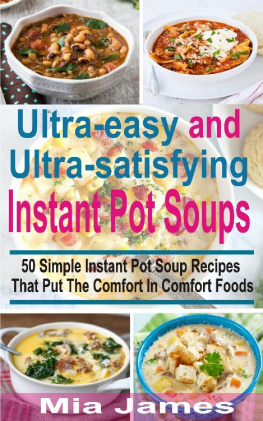

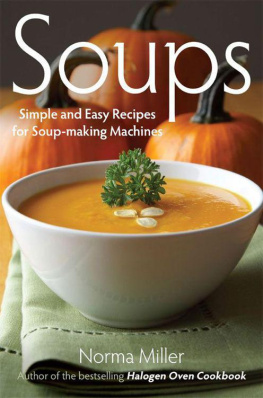
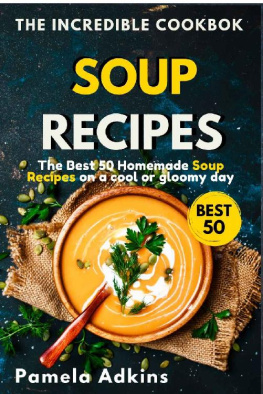


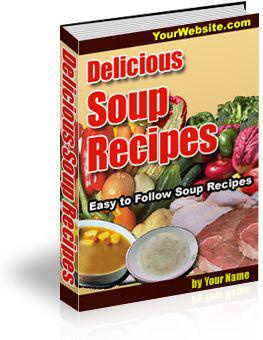

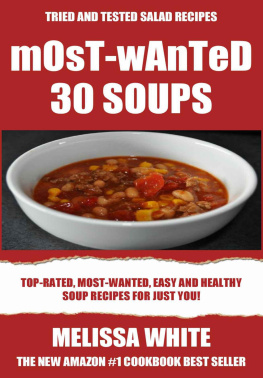
 CONTENTS
CONTENTS  HOW TO USE THIS EBOOK Select one of the chapters from and you will be taken to a list of all the recipes covered in that chapter. Alternatively, jump to the to browse recipes by ingredient. Look out for linked text (which is in blue) throughout the ebook that you can select to help you navigate between related recipes. You can double tap images and tables to increase their size. To return to the original view, just tap the cross in the top left-hand corner of the screen. INTRODUCTION From light lunches to something more substantial soups can be healthy, comforting, hearty and nourishing, as well as easy to incorporate into your daily diet.
HOW TO USE THIS EBOOK Select one of the chapters from and you will be taken to a list of all the recipes covered in that chapter. Alternatively, jump to the to browse recipes by ingredient. Look out for linked text (which is in blue) throughout the ebook that you can select to help you navigate between related recipes. You can double tap images and tables to increase their size. To return to the original view, just tap the cross in the top left-hand corner of the screen. INTRODUCTION From light lunches to something more substantial soups can be healthy, comforting, hearty and nourishing, as well as easy to incorporate into your daily diet. USING YOUR SOUP MAKER There are some factors to take into consideration when using your soup maker: The capacity of the soup maker: This will vary depending on the brand of soup maker you have, so do check the minimum and maximum levels and ensure you stick to them when adding ingredients. If you need to add a little less liquid you may have a thicker consistency soup that can be loosened with extra stock, cream or other liquid when the soup is cooked and served. Saut function in soup makers: In most cases this can only be used with the lid removed from the jug and for no longer than 10 minutes. Sauting is perfect for onions, celery, peppers, carrots or bacon lardons where they need to be softened or browned.
USING YOUR SOUP MAKER There are some factors to take into consideration when using your soup maker: The capacity of the soup maker: This will vary depending on the brand of soup maker you have, so do check the minimum and maximum levels and ensure you stick to them when adding ingredients. If you need to add a little less liquid you may have a thicker consistency soup that can be loosened with extra stock, cream or other liquid when the soup is cooked and served. Saut function in soup makers: In most cases this can only be used with the lid removed from the jug and for no longer than 10 minutes. Sauting is perfect for onions, celery, peppers, carrots or bacon lardons where they need to be softened or browned. The recipes in this book were tested with a soup maker with a minimum capacity of 1.3 litres (2 pints) and a maximum of 1.6 litres (2 pints). The soup maker also featured a saut function which allowed the cooking process to be paused and the lid removed so that further ingredients can be added. It is worth noting that you should not saut in a soup maker for longer than 10 minutes for risk of the ingredients getting burnt.
The recipes in this book were tested with a soup maker with a minimum capacity of 1.3 litres (2 pints) and a maximum of 1.6 litres (2 pints). The soup maker also featured a saut function which allowed the cooking process to be paused and the lid removed so that further ingredients can be added. It is worth noting that you should not saut in a soup maker for longer than 10 minutes for risk of the ingredients getting burnt.